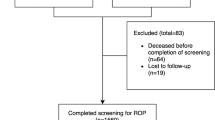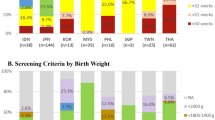Abstract
OBJECTIVE:
To assess neonatal intensive care unit (NICU) practices affecting screening and follow-up for retinopathy of prematurity (ROP).
METHODS:
Retrospective study of infants at risk for ROP, eligible for back transport, admitted to a regional NICU from January 1, 1999 until May 31, 2002. Patients failed to receive needed follow-up for ROP after discharge or transfer from a NICU, if we could not verify their ROP screening follow-up within 1 month.
RESULTS:
A total of 74 infants were identified to need follow-up eye care. Infants who did not receive the follow-up care had greater mean gestational age (mean SD; 30.7±2.3 vs 29.6±2.5 weeks, p=0.05) and birth weights (mean SD; 1581±366 vs 1360±508 g, p=0.007), compared to infants who received the recommended care. Infants transported back to the community hospital were significantly more likely to miss follow-up eye care compared to infants discharged from the regional center (relative risk 2.81, 95% confidence interval (CI) (1.09 to 7.20)). Infants not screened for ROP in the NICU had greater risk for missing follow-up care compared to infants who had their first retinal examination in the NICU (relative risk 4.25, 95% CI (1.42 to 12.73)).
CONCLUSIONS:
Infants transferred back or discharged from the NICU before ROP screening represent a high-risk group for not receiving follow-up eye care.
This is a preview of subscription content, access via your institution
Access options
Subscribe to this journal
Receive 12 print issues and online access
$259.00 per year
only $21.58 per issue
Buy this article
- Purchase on Springer Link
- Instant access to full article PDF
Prices may be subject to local taxes which are calculated during checkout
Similar content being viewed by others
References
Cryotherapy for Retinopathy of Prematurity Cooperative Group. Multicenter trial of cryotherapy for retinopathy of prematurity. Preliminary results. Arch Ophthalmol 1988;106:471–479.
Paysse EA, Lindsey JL, Coats DK, Contant Jr CF, Steinkuller PG . Therapeutic outcomes of cryotherapy versus transpupillary diode laser photocoagulation for threshold retinopathy of prematurity. J AAPOS 1999;3:234–240.
Cryotherapy for Retinopathy of Prematurity Cooperative Group. Multicenter trial of cryotherapy for retinopathy of prematurity. Snellen visual acuity and structural outcome at 5 1/2 years after randomization. Arch Ophthalmol 1996;114:417–424.
Cryotherapy for Retinopathy of Prematurity Cooperative Group. Multicenter trial of cryotherapy for retinopathy of prematurity: ophthalmological outcomes at 10 years. Arch Ophthalmol 2001;119:1110–1118.
Recchia FM, Capone Jr A . Contemporary understanding and management of retinopathy of prematurity. Retina 2004;24:283–292.
Demorest BH . Retinopathy of prematurity requires diligent follow-up care. Surv Ophthalmol 1996;41:175–178.
Aprahamian AD, Coats DK, Paysse EA, Brady-Mccreery K . Compliance with outpatient follow-up recommendations for infants at risk for retinopathy of prematurity. J AAPOS 2000;4:282–286.
Horbar JD, Badger GJ, Carpenter JH, et al. Trends in mortality and morbidity for very low birth weight infants, 1991–1999. Pediatrics 2002;110:143–151.
Bode MM, O'Shea TM, Metzguer KR, Stiles AD . Perinatal regionalization and neonatal mortality in North Carolina, 1968–1994. Am J Obstet Gynecol 2001;184:1302–1307.
American Academy of Pediatrics and the American College of Obstetrics and Gynecology. Guidelines for Perinatal Care, 5th edition. Elk Grove Village, IL: American Academy of Pediatrics; Washington, DC: American College of Obstetrics and Gynecology, 2002.
Attar M, Schumacher R . Retinopathy of prematurity. In: Donn S, editor. The Michigan Manual: A Guide to Neonatal Intensive Care. 2nd ed. Armonk, NY: Futura Publishing Company; 1997. p. 371–375.
Section on Ophthalmology. Screening examination of premature infants for retinopathy of prematurity. Pediatrics 2001;108:809–811.
Sanderson M, Sappenfield WM, Jespersen KM, Liu Q, Baker SL . Association between level of delivery hospital and neonatal outcomes among South Carolina Medicaid recipients. Am J Obstet Gynecol 2000;183:1504–1511.
Phibbs CS, Mortensen L . Back transporting infants from neonatal intensive care units to community hospitals for recovery care: effect on total hospital charges. Pediatrics 1992;90:22–26.
Hutchinson AK, O'Neil JW, Morgan EN, Cervenak MA, Saunders RA . Retinopathy of prematurity in infants with birth weights greater than 1250 grams. J AAPOS 2003;7:190–194.
Wright K, Anderson ME, Walker E, Lorch V . Should fewer premature infants be screened for retinopathy of prematurity in the managed care era? Pediatrics 1998;102:31–34.
Conrath JG, Hadjadj EJ, Forzano O, et al. Screening for retinopathy of prematurity: results of a retrospective 3-year study of 502 infants. J Pediatr Ophthalmol Strabismus 2004;41:31–34.
Author information
Authors and Affiliations
Additional information
Financial Support: Michigan Department of Community Health Grant.
Rights and permissions
About this article
Cite this article
Attar, M., Gates, M., Iatrow, A. et al. Barriers to Screening Infants for Retinopathy of Prematurity after Discharge or Transfer from a Neonatal Intensive Care Unit. J Perinatol 25, 36–40 (2005). https://doi.org/10.1038/sj.jp.7211203
Published:
Issue Date:
DOI: https://doi.org/10.1038/sj.jp.7211203
This article is cited by
-
Awareness of retinopathy of prematurity among pediatricians in West Bank, Palestine: a descriptive study
BMC Ophthalmology (2018)
-
Postnatal follow-up of antenatal hydronephrosis: a health-care challenge
Journal of Perinatology (2009)
-
Back Transport of Neonates: Effect on Hospital Length of Stay
Journal of Perinatology (2005)



